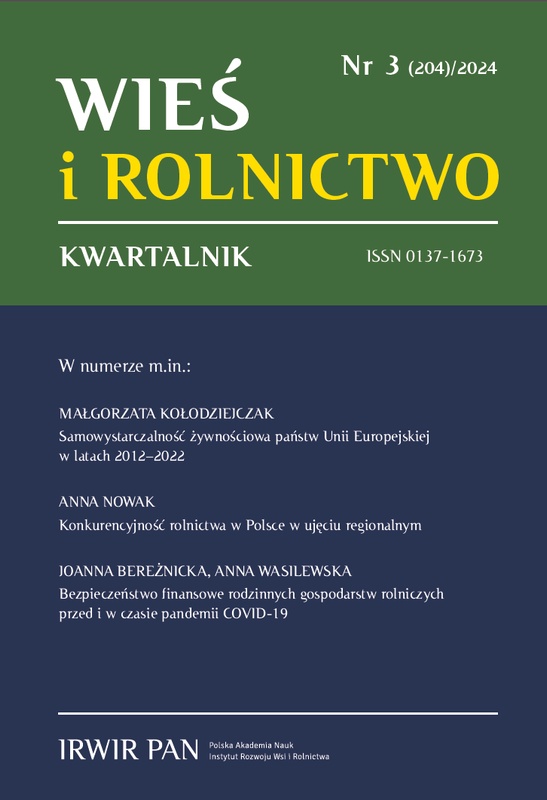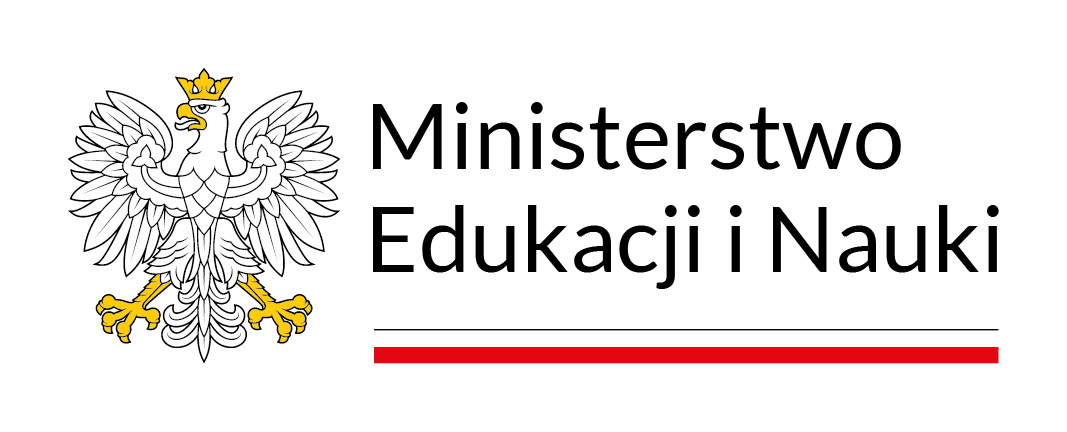Food Self-Sufficiency of the European Union Countries in 2012–2022
DOI:
https://doi.org/10.53098/wir.2024.3.204/01Keywords:
agricultural production, food security, food self-sufficiency, food waste, The European Green DealAbstract
The aim of this paper is to assess the level of food self-sufficiency in the European Union under a hypothetical crisis scenario in which supply chains are disrupted and international food trade is either severely restricted or impossible. The study is based on FAOSTAT data and a review of relevant literature. A comparative method was employed, utilising a food self-sufficiency index, with values estimated from average food production and consumption between 2012 and 2022. Under a closed economy, the EU-27 either achieved or came close to achieving self-sufficiency across all analysed food categories; however, individual member states were not entirely food self-sufficient. Therefore, intracommunity food exchange remains necessary even in the examined crisis scenario, along with the maintenance of national reserves. Additionally, reducing food waste is crucial. A potential risk to the European Union’s food self-sufficiency is a decrease in food production due to the implementation of European Green Deal requirements.
References
Baer-Nawrocka A. (2014). Zmiany w spożyciu i stopniu samowystarczalności żywnościowej w Unii Europejskiej. Prace Naukowe Uniwersytetu Ekonomicznego we Wrocławiu = Research Papers of Wrocław University of Economics, 360, 19–27. DOI: https://doi.org/10.15611/pn.2014.360.02
Clapp J. (2017). Food self-sufficiency: Making sense of it, and when it makes sense. Food Policy, 66, 88–96. DOI: https://doi.org/10.1016/j.foodpol.2016.12.001
Dziennik Urzędowy UE (2019). Umowa o wystąpieniu Zjednoczonego Królestwa Wielkiej Brytanii i Irlandii Północnej z Unii Europejskiej i Europejskiej Wspólnoty Energii Atomowej. 2019/C 384 I/01. Dz.U. C 384I z 12.11.2019.
Dzwonkowski W. (2017). Ewolucja produkcji ziemniaków w Polsce i UE. Zeszyty Naukowe Szkoły Głównej Gospodarstwa Wiejskiego w Warszawie. Problemy Rolnictwa Światowego, 17 (32), 3, 71–80. DOI: https://doi.org/10.22630/PRS.2017.17.3.54
EUROSTAT (2023). Food waste and food waste prevention – estimates. https://ec.europa.eu/eurostat/statistics-explained/index.php?title=Food_waste_and_food_waste_prevention_-_estimates (dostęp: 30.05.2024).
FAO [Food and Agriculture Organization of the United Nations] (2012). Statistical Yearbook 2012: World Food and Agriculture. Part 5 – Metadata. FAO. Rome, Italy. https://www.fao.org/4/i2490e/i2490e05.pdf (dostęp: 12.08.2024).
FAO (2003). Trade Reforms and Food Security: Conceptualizing the Linkages. Rome.
FAO, IFAD, UNICEF, WFP, WHO (2022). The State of Food Security and Nutrition in the World 2022. Repurposing food and agricultural policies to make healthy diets more affordable. Rome: FAO. https://openknowledge.fao.org/server/api/core/bitstreams/6ca1510c-9341-4d6a-b285-5f5e8743cc46/content/cc0639en.html (dostęp: 12.08.2024).
FAOSTAT [Food and Agriculture Organization Statistics] (2024a). Database. https://www.fao.org/faostat/en/#data (dostęp: 01.05.2024).
FAOSTAT (2024b). Database. https://www.fao.org/faostat/en/#data/FBS/metadata (dostęp: 15.04.2024).
FAOSTAT (2023). Food Balances (2010–) – Metadata. https://www.fao.org/faostat/en/#data/FBS/metadata (dostęp: 16.08.2024).
FUSIONS EU (2016). European Food Waste Levels. https://www.eu-fusions.org/phocadownload/Publications/Estimates%20of%20European%20food%20waste%20levels.pdf (dostęp: 30.05.2024).
Gradziuk P., Matyka M., Poczta W., Czerniak A., Czubak W., Jończyk K., Kopiński J., Kozyra J., Pawlak K., Sadowski A., Siebielec G., Stalenga J., Wawer R., Zawalińska K., Berbeć A., Krupin V., Madej A., Skowron P., Jendrzejewski B., Komisarek D., Łopatka A., Wojciechowska A., Klepacki B., Wrzaszcz W., Gradziuk K., Trocewicz A. (2021). Wpływ Europejskiego Zielonego Ładu na polskie rolnictwo. Raporty Polityki Insight 2021. Warszawa: Polityka Insight Sp. z o.o.
Infrastruktura i Środowisko (2021). Ministerstwo Funduszy i Polityki Regionalnej, Program Infrastruktura i Środowisko. Europejski Zielony Ład w pytaniach i odpowiedziach. https://www.pois.gov.pl/media/98573/zielony_lad_broszura_wersja_dostepna.pdf (dostęp: 20.03.2024).
KE [Komisja Europejska] (2019). Europejski Zielony Ład. Aspirowanie do miana pierwszego kontynentu neutralnego dla klimatu. https://commission.europa.eu/strategy-and-policy/priorities-2019-2024/european-green-deal_pl (dostęp: 14.04.2024).
Kołodziejczak M. (2018). Food self-sufficiency in EU countries: An attempted projection to 2080. W: Proceedings of the 27th International Scientific Conference Agrarian Perspectives XXVII. Food Safety – Food Security. September 19–20, 2018 (s. 136–143). Prague: Czech University of Life Sciences.
Kubala S., Stanuch M. (2021). An assessment of the self-sufficiency level of selected countries in Central and Eastern Europe in poultry meat production. Annals of the Polish Association of Agricultural and Agribusiness Economists, 23 (4), 96–107. DOI: https://doi.org/10.5604/01.3001.0015.5714
Kwasek M. (2018). Samowystarczalność żywnościowa Polski na tle Unii Europejskiej. Przemysł Spożywczy, 11, 2–6. DOI: https://doi.org/10.15199/65.2018.11.1
Pawlak K., Kołodziejczak M. (2020). The role of agriculture in ensuring food security in developing countries: Considerations in the context of the problem of sustainable food production. Sustainability, 12 (13), 5488. DOI: https://doi.org/10.3390/su12135488
PSZRiŻ [Polskie Stowarzyszenie Zrównoważonego Rolnictwa i Żywności] (2024). Europejski Zielony Ład. Unijna strategia na rzecz bioróżnorodności i Unijna strategia od pola do stołu. https://rolnictwozrownowazone.pl/rolnictwo-zrownowazone/wspolna-polityka-rolna-finansowanie/europejski-zielony-lad/ (dostęp: 10.03.2024).
Rada UE (2024). Europejski zielony ład. https://www.consilium.europa.eu/pl/policies/green-deal/ (dostęp: 29.04.2024).
Servolin C. (2005). Gospodarka rolna – między polityką a ekonomią. Wieś i Rolnictwo, 4 (129), 9–17.
Sobiecki R. (2007). Globalizacja a funkcje polskiego rolnictwa. Warszawa: Szkoła Główna Handlowa – Oficyna Wydawnicza.
Szajner P. (red.) (2013). Światowa produkcja biopaliw w kontekście bezpieczeństwa żywnościowego. Seria: Program Wieloletni 2011–2014, 70. Warszawa: Instytut Ekonomiki Rolnictwa i Gospodarki Żywnościowej – PIB.
USDA [United States Department of Agriculture] (2020). Economic and Food Security Impacts of Agricultural Input Reduction Under the European Union Green Deal’s Farm to Fork and Biodiversity Strategies. https://www.ers.usda.gov/webdocs/publications/99741/eb-30.pdf?v=2064.4 (dostęp: 30.05.2024).
Wageningen University and Research (2022). Green Deal probably leads to lower agricultural yields. https://www.wur.nl/en/news-wur/Show/Green-Deal-probably-leads-tolower-agricultural-yields.htm (dostęp: 30.05.2024).











